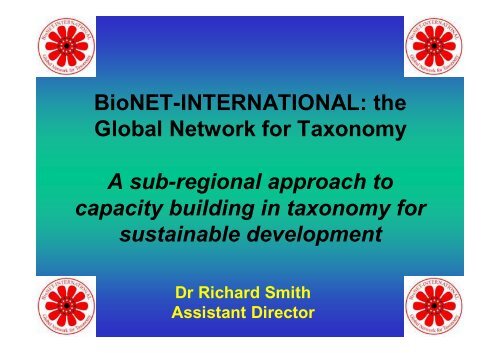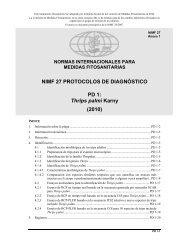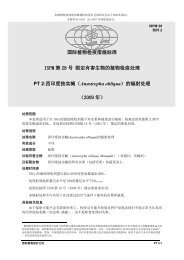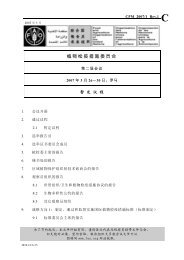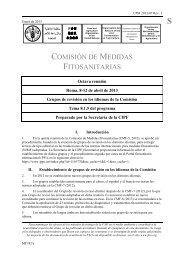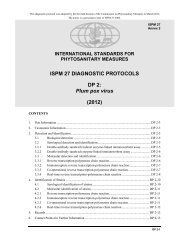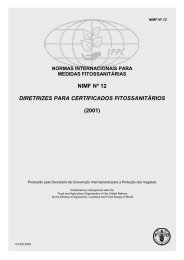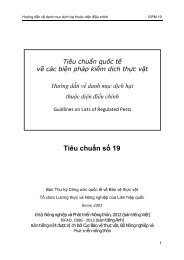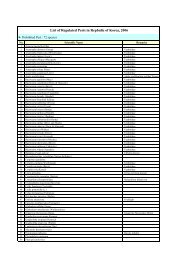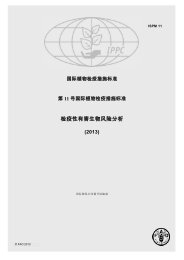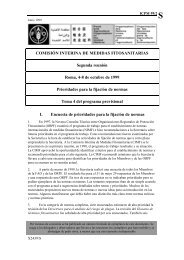BioNET-INTERNATIONAL: the Global Network for Taxonomy A sub ...
BioNET-INTERNATIONAL: the Global Network for Taxonomy A sub ...
BioNET-INTERNATIONAL: the Global Network for Taxonomy A sub ...
- No tags were found...
Create successful ePaper yourself
Turn your PDF publications into a flip-book with our unique Google optimized e-Paper software.
<strong>BioNET</strong>-<strong>INTERNATIONAL</strong>: <strong>the</strong><strong>Global</strong> <strong>Network</strong> <strong>for</strong> <strong>Taxonomy</strong>A <strong>sub</strong>-regional approach tocapacity building in taxonomy <strong>for</strong>sustainable developmentDr Richard SmithAssistant Director
Taxonomic impedimentTaxonomic Expertise and In<strong>for</strong>mation:not where it is needed• 95% of existing taxonomic expertise resides in“developed” countries• 95% of taxonomic in<strong>for</strong>mation and collectionsreside in “developed” countries• 95% of remaining biodiversity resides indeveloping countries!• Regional imbalances• expertise is rapidly ‘greying’ and not beingreplaced
Taxonomic ImpedimentRecent international responses• Darwin Declaration (1999) The Taxonomic Impediment• CBD CoP5 (May 2000) Decision (V/9) on a <strong>Global</strong><strong>Taxonomy</strong> Initiative (GTI)• CBD CoP6 (April 2002) approved GTI Programme of Work• 3GTW-Pretoria (July 2002) Partnership approach to GTI• WSSD Plan of Implementation (September 2002)Emphasized importance of GTI in delivering biodiversitytargets• 3GTW-Paris (February 2003) Commitments to Action Plan<strong>for</strong> GTI
<strong>BioNET</strong>-<strong>INTERNATIONAL</strong>basics• A not-<strong>for</strong>-profit, donor-funded, global programmefounded in 1993…• …to help build <strong>the</strong> taxonomic capacity needed by“developing countries” <strong>for</strong> sustainable development;• 10 inter-institutional <strong>sub</strong>regional networks…morebeing established• supported by a Technical Secretariat• NOT an Internet-based in<strong>for</strong>mation network!• NOT a database!• NOT a donor agency!
What is a <strong>BioNET</strong>-<strong>INTERNATIONAL</strong> LOOP?= TechnicalCooperation<strong>Network</strong>permanent structure, ownedand operated by memberinstitutions andgovernmentsLocallyOwned andOperatedPartnership
Regional cooperationMobilisation and pooling ofresources benefits all• Significant expansion in capabilities andservices• cost effective coordination andimplementation of capacity building projects• address common issues such as invasivespecies / integrated pest management• realistic goal of <strong>sub</strong>regional self-reliance
LOOP model
The <strong>BioNET</strong> LOOPs
Objectives of a <strong>BioNET</strong>-<strong>INTERNATIONAL</strong> LOOP• Respond to identified national andregional priorities• facilitate, coordinate and promotetaxonomic capacity building• help users of taxonomy to developtaxonomic services and products usingregional expertise• help regions become self-reliant intaxonomy
IAS and IPPC: need <strong>for</strong> taxonomy…how LOOPs can assist• NEEDS: Pest reporting, certification / verification(export/import), identification, surveillance,inspection, exotic pest response, pest listing• LOOPs:– Permanent, government-endorsed <strong>sub</strong>-regionalcapacity building programmes– Capability and needs assessment– Organising delivery of training and technologies– In<strong>for</strong>mation sharing– Links via <strong>Global</strong> <strong>Network</strong> to experts and technologyproviders
TrainingTraining of 38 taxonomic technicians working in quarantine supportorganised by SAFRINET <strong>for</strong> FAO
<strong>BioNET</strong> LOOPs:invasives, phytosanitary andquarantine support• ANDINONET: proposal <strong>for</strong> a Phytosanitaryand IPM knowledge base and regionaltaxonomic support service• ASEANET: Capacity needs identification <strong>for</strong>IAS management• SAFRINET: invasives in<strong>for</strong>mation hub;identification tools; automated systems• WAFRINET: SP-IPM programme of CGIAR• Technical Partners: Discoverlife,EUROLOOP, o<strong>the</strong>rs
Communicating…
Recent products
LOOPs - facilitating partnerships
Ist <strong>BioNET</strong>-<strong>INTERNATIONAL</strong> <strong>Global</strong>Workshop (BIGW1) 1995, Cardiff2nd <strong>BioNET</strong>-<strong>INTERNATIONAL</strong> <strong>Global</strong>Workshop (BIGW2) 1999, Cardiff3rd <strong>BioNET</strong>-<strong>INTERNATIONAL</strong><strong>Global</strong> <strong>Taxonomy</strong> Workshop 8-12July 2002, Pretoria, South Africa:“Towards SustainableDevelopment - Partnerships <strong>for</strong>building demand-driventaxonomic capacity”
3GTW July 2002 and February 2003Partnerships <strong>for</strong> building demanddriventaxonomic capacity• Organised by <strong>BioNET</strong> in collaboration withUNESCO-MAB, CBD and IPPC Secretariats• 300 participants• Taxonomists from 95 countries• Users (IUCN, CI, WWF, CBD, IPPC, etc.)• Technology and tool developers (GBIF,Fishbase, Discoverlife, EcoPort, ETI, SP2000,etc.)• Resourcing / funding (UNEP-GEF, UNDP-GEF)• OUTPUT: Action Plan <strong>for</strong> <strong>the</strong> <strong>Global</strong> <strong>Taxonomy</strong>Initiative
GTI Action Plan- 9 elements!End-user driven!Political Partnership!<strong>Global</strong> Partnership!Awareness and Action!Capacity Building!Science!Taxonomic In<strong>for</strong>mation!Timelines!Resourcing
Convention on Biological Diversity,<strong>Global</strong> <strong>Taxonomy</strong> Initiative and<strong>BioNET</strong>-<strong>INTERNATIONAL</strong>GTI Programme of Work (Decision VI/8)recognises that <strong>the</strong> LOOPs of <strong>BioNET</strong>-<strong>INTERNATIONAL</strong> can help with:– needs assessments– awareness raising– regional cooperation– coordination and implementation of capacitybuilding
The<strong>Global</strong> <strong>Taxonomy</strong>InitiativeContents•The CBD•The GTI•GTI WorkProgramme•Taxonomic needsassessments•Capacity BuildingCapacity BuildingCollaboration between initiatives is vital tobuild appropriate capacityThe GTI Programme of Work cites initiatives including:• <strong>BioNET</strong>-<strong>INTERNATIONAL</strong> and its LOOPs• GBIF• GISP• etcas important partners, and emphasises <strong>the</strong>ir roles inimplementation3 rd <strong>Global</strong> <strong>Taxonomy</strong>WorkshopJuly 2002
The<strong>Global</strong> <strong>Taxonomy</strong>InitiativeCapacity BuildingContents•The CBD•The GTI•GTI WorkProgramme•Taxonomic needsassessments•Capacity Building“Capacity development at <strong>the</strong> national andregional levels ..[is].. a driving <strong>for</strong>ce inimplementing <strong>the</strong> programme of work”COPVI/83 rd <strong>Global</strong> <strong>Taxonomy</strong>WorkshopJuly 2002
Thank you!Interested?Contact your Regional and National Coordinatorsvia bionet@bionet-intl.orgwww.bionet-intl.org...stay in touchBulletin - emailed monthly(English, Spanish, French)upcoming events | product announcements


